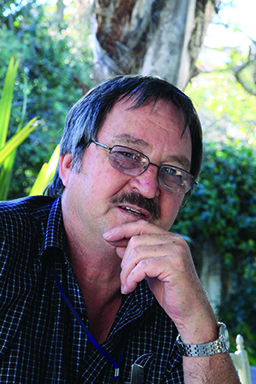
Prof HO de Waal, affiliated researcher
at the University of the Free State,
says farmers should save grazing
during the summer months to have
fodder available in the winter and
early spring.
Photo: Theuns Botha,
Landbouweekblad
“Farmers should save veld during the summer months to have grazing available for animals especially in the winter and early spring. Farmers should also adjust livestock numbers timely and wisely according to the available material in the field,” says Prof HO de Waal, professional animal scientist and affiliated researcher in the Department of Animal, Wildlife and Grassland Sciences at the University of the Free State.
He offered this advice as a result of the sporadic and scattered (scant) rainfall of the past couple of summers. “In retrospect we know that this kind of precipitation started in about 2014 and has continued in subsequent summers. In February 2015, it was clear that a major fodder scarcity was developing.”
Existing research methods serve as source of current knowledge
Dr Herman Fouché (Agricultural Research Council) has conducted research on the impact of climate, especially rainfall, on the growth of grass. Sophisticated computer technology developed as far back as the 1980s to – through modelling – predicts the impact of climate on field production during the growing season.
The impact of climate, and more specifically rainfall, on field production has been known to animal and grazing scientists for a long time. Prof De Waal used the modelling results to determine the impact of rainfall on grass as a feeding source for animals.
“Information that emerged from this old research programme could therefore be applied directly to animal production,” says Prof De Waal.
Adjust livestock numbers to availability of grazing
In the summer rainfall areas of South Africa, grass usually grows from the end of August and early September. The growth process is dependent on the transfer of soil moisture, as well as on rainfall during the winter and early spring.
“Livestock numbers should be balanced throughout the year (according to the nutritional needs and production of the animals) with the availability of grazing material – be consistent, not only during certain seasons or when drought is imminent,” is Prof De Waal’s advice to farmers. “Farmers are also encouraged to carefully reduce the number of livestock on grazing and to rather focus their attention and limited resources on the remaining breeding herds (cows and ewes).”
“It is tragic, but unfortunately many farmers will not survive the effects of recent years. Similar climatic conditions will occur, with the same tragic consequences for man and beast. Better planning has to start now.” The assistance of private institutions, individuals, as well as the government, during the severe droughts is gratefully acknowledged.
Spineless cactus pear as solution for scarcity of animal feed
Prof De Waal says spineless cactus pears could be used as a feeding source during droughts. “The effects of a severe drought, or major animal-feed scarcity, are still prevalent in large parts of the subcontinent.” This may act as a catalyst to utilise spineless cactus pears as a feeding source and to be incorporated in the feed-flow programme for livestock on natural grazing.